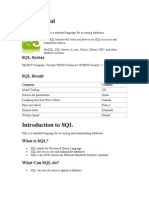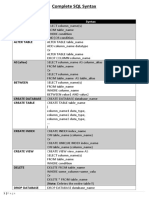Sqlshack: SQL Server Performance Monitoring With Data Collector
Uploaded by
Makv2lisSqlshack: SQL Server Performance Monitoring With Data Collector
Uploaded by
Makv2lisSQLShack Español
SQL Server performance monitoring with Data Collector Newsletter
February 19, 2014 by Milena Petrovic
Enter your email
What is SQL Server Data Collector
Subscribe
SQL Server Data Collector is a feature for performance monitoring and tuning available in SQL Server
Management Studio. It was introduced in SQL Server 2008 and is available in the Enterprise, Standard, Business
Intelligence, and Web editions
What information can it gather?
Data Collector can gather performance information from multiple SQL Server instances and store it in a single
repository. It has three built-in data collecting specifications (data collectors) designed to collect the most
important performance metrics. The information collected by default is about disk usage, query statistics, and
server activity. You can also create additional data collectors and monitor more metrics
How does Data Collector work?
Popular
Data Collector can run constantly, or on a pre-defined schedule
How to copy tables from one database to another in
SQL Server
“The data collector also uses a data warehouse, a relational database that enables you to manage the data that Multiple options to transposing rows into columns
you collect by setting different retention periods for your data.” [1]
How to connect to a remote SQL Server
Database table partitioning in SQL Server
It is recommended for the Management Data Warehouse (MDW) database to be stored in a non-production SQL
A beginner’s guide to SQL Server transaction logs
Server instance. The best solution is to use a SQL Server instance designated only for the MDW, as the feature
doesn’t have an option to exclude a specific database from data collecting. Keep in mind that the MDW can A DBA guide to SQL Server performance
troubleshooting – Problems and performance
grow fast and make sure you have enough free disk space available. The MDW growth rate depends on the metrics
number of transactions, and for high-transaction databases, this can be a couple of hundred MBs a day
Troubleshooting the CXPACKET wait type in SQL
Server
One DMW database can be used as a central database repository for all monitored SQL Server instances SQL Server query execution plans – Understanding
and reading the plans
The data it captures is not only displayed in real-time graphs, like with Activity Monitor, but also saved for later SQL Server 2014 – Install a clustered instance – step-
by-step (1/3)
analysis
How to create and configure a linked server in SQL
Server Management Studio
Besides Data Warehousing, Data Collector uses SQL Server Agent and Integration Services
Using SSIS packages to import MS Excel data into a
database
Once Data Collector is enabled, it creates a number of scheduled jobs necessary for automatic data collection
How to install Microsoft SQL Server Express LocalDB
and data upload into the MDW database. They are also used to purge stored. The feature also adds tables to the
SQL Server query execution plans – Viewing the
msdb database, to store the configuration, auditing and collection history information, job information and SSIS
plans
packages
Connecting PowerShell to SQL Server
Querying remote data sources in SQL Server
Integration Services packages transform and load the collected data into the MDW database
SQL Server cursor tutorial
“Collection sets are defined and deployed on a server instance and can be run independently of each other. Each How to migrate the logins of a database to a
different server
collection set can be applied to a target that matches the target types of all the collector types that are part of a
Creating and using CRUD stored procedures
collection set. The collection set is run by a SQL Server Agent job or jobs, and data is uploaded to the management
data warehouse on a predefined schedule.” [1] 10 most important SQL Server transaction log myths
Reading the SQL Server Transaction Log
Predefined data collection sets
Solutions
The Disk Usage data collection set collects information about disk space used by both data and log files for all
Read a SQL Server transaction log
databases on the SQL Server instance, growth trends, and average day growth
SQL Server database auditing techniques
How to recover SQL Server data from accidental
UPDATE and DELETE operations
How to quickly search for SQL database data and
By default, the Disk Usage data collection set collects data every 60 seconds and uploads data into the MDW objects
database every 6 hours in non-cached mode
Synchronize SQL Server databases in different
remote sources
“In non-cached mode, collection and upload are on the same schedule. The packages start, collect, and upload data Recover SQL data from a dropped table without
at their configured frequency, and run until they are finished. There is only one job created for collection sets in backups
non-cached mode. Non-cached mode allows for the collection and uploading of data to occur on demand, as well How to restore specific table(s) from a SQL Server
as at the intervals specified in the job.” [2] database backup
Recover deleted SQL data from transaction logs
The Query Statistics data collection set collects information about query statistics, activity, execution plans and How to recover SQL Server data from accidental
updates without backups
text on the SQL Server instance. It does not store all executed statements, only 10 worst performing ones
Automatically compare and synchronize SQL Server
data
Open LDF file and view LDF file content
To collect more than top 10 worst performing queries, disable the default Query Statistics Collection Set and Quickly convert SQL code to language-specific client
code
create a custom one using T-SQL or its API
How to recover a single table from a SQL Server
database backup
The Query Statistics data collection set uploads the collected data in the cached mode
Recover data lost due to a TRUNCATE operation
without backups
“In cached mode, the data collection and uploading of jobs are on different schedules, so two jobs are created for How to recover SQL Server data from accidental
each collection set. Cached mode supports continuous collection of data, but less frequent uploads. For example, DELETE, TRUNCATE and DROP operations
the default Server Activity collection set uploads data by default every 15 minutes. However, the collection items are Reverting your SQL Server database back to a
collected every 60 seconds.” [2] specific point in time
How to create SSIS package documentation
In the cached more, one SQL Server job is executed every 60 seconds to collect the data. This data is stored Migrate a SQL Server database to a newer version of
(cached) into a local cache folder. Another job is run every 15 minutes to read the cached data and insert it into SQL Server
the MDW database How to restore a SQL Server database backup to an
older version of SQL Server
The cashed mode creates less overhead than non-cached
The Server Activity collection set collects information about resource usage (CPU, memory, disk I/O, and
network), SQL Server waits, instance activity (batch requests, logouts, SQL compilations and recompilations,
transactions, user connections, and logins), and operating system activity. Data is collected every 60 seconds and
uploaded in cached mode every 15 minutes
The Data Collector feature is pre-defined to collect the data necessary to identify and troubleshoot most
common SQL Server performance problems. It can be set up easily, without coding. If you want to collect more
than the pre-defined metrics, you can create custom collection sets, but coding is required. The feature provides
comprehensive built-in reports for the default collection sets. In the next part of this series, we will give steps to Categories
set up the necessary pre-requests and start data collecting
Auditing (16)
Backup and restore (27)
See more
► Business Intelligence (147)
To get 3 free licenses to a SQL Server monitoring tool, please download ApexSQL Monitor and fill out this simple Cursors (5)
survey Database design (62)
► Database development (175)
References Lists (3)
Maintenance (55)
[1] MSDN – Data Collection
▼ Performance tuning (232)
[2] MSDN -SQL Server 2008 Management Data Warehouse
Alerting (3)
Availability Group (AG) (11)
Useful resources
Buffer Pool Extension (BPE) (5)
Common Table Expressions (CTE) (3)
MSDN – Monitoring SQL Server Performance
MSDN – Manage Data Collection Deadlocks (9)
TechNet Webcast: SQL Server 2008: New Performance Monitoring and Troubleshooting Using Management In-Memory OLTP (13)
Studio Indexes (33)
Latches (2)
Locking (1)
Monitoring (17)
Performance (39)
Performance counters (15)
Milena Petrovic Query analysis (52)
Milena is a SQL Server professional with more than 20 years of experience in IT. She has started Reports (6)
with computer programming in high school and continued at University.
Skewed data (1)
She has been working with SQL Server since 2005 and has experience with SQL 2000 through SQL Spinlocks (1)
2014.
SSAS monitoring (2)
Her favorite SQL Server topics are SQL Server disaster recovery, auditing, and performance SSIS monitoring (2)
monitoring. SSRS monitoring (3)
Views (3)
View all posts by Milena "Millie" Petrovic
Wait types (7)
Professional development (8)
Recovery (31)
Related Posts:
Security (39)
1. SQL Server performance monitoring with Data Collector – Part 2 – set-up and usage
SQL Azure (68)
2. SQL Server performance monitoring with Data Collector – Part 3 – reading the reports
SQL Commands (19)
3. A DBA guide to SQL Server performance troubleshooting – Part 2 – Monitoring utilities
4. SQL Server performance tuning using Windows Performance Monitor SQL Server 2012 (2)
5. SQL Server Management Studio performance reports SQL Server 2016 (68)
SQL Server 2017 (25)
Monitoring SQL Server Management Studio (SSMS) (40)
SQL Server on Linux (5)
24,711 Views SQL Server partitioning (8)
Training (9)
Transaction Log (15)
Helpers and best practices
BI performance counters
SQL Server wait types
© 2018 · ApexSQL · All Rights Reserved
You might also like
- Apache Cassandra Administrator Associate - Exam Practice TestsFrom EverandApache Cassandra Administrator Associate - Exam Practice TestsNo ratings yet
- Database Systems For Software Engineers SOEN 363 - Winter 2023 Assignment 1No ratings yetDatabase Systems For Software Engineers SOEN 363 - Winter 2023 Assignment 15 pages
- SQL Developer and SQL DBA Training Masters ProgramNo ratings yetSQL Developer and SQL DBA Training Masters Program10 pages
- Total Experience: 6 Year(s) 0 Month(s) Annual Salary: Rs 7.0 Lac(s)No ratings yetTotal Experience: 6 Year(s) 0 Month(s) Annual Salary: Rs 7.0 Lac(s)7 pages
- YAPP (Oracle) Yet Another Performance Profiling MethodNo ratings yetYAPP (Oracle) Yet Another Performance Profiling Method28 pages
- SQL Select Statement: SELECT FROM Customers WHERE Country 'Mexico'No ratings yetSQL Select Statement: SELECT FROM Customers WHERE Country 'Mexico'6 pages
- SQL Queries (Interview Questions and Answers On "SQL Select" - ExamplesNo ratings yetSQL Queries (Interview Questions and Answers On "SQL Select" - Examples6 pages
- Types of Join in SQL Server - CodeProjectNo ratings yetTypes of Join in SQL Server - CodeProject6 pages
- Accenture Data Analyst Interview QuestionsNo ratings yetAccenture Data Analyst Interview Questions17 pages
- Oracle 11g DBA PLSQL LINUX Course ContentNo ratings yetOracle 11g DBA PLSQL LINUX Course Content12 pages
- Understanding SQL Server Configuration Manager - CodeProjectNo ratings yetUnderstanding SQL Server Configuration Manager - CodeProject6 pages
- Oracle Performance Tuning - Oracle Partitioning - IntroductionNo ratings yetOracle Performance Tuning - Oracle Partitioning - Introduction57 pages
- SQL Server 2008/2012: Database Administrator Class 1No ratings yetSQL Server 2008/2012: Database Administrator Class 169 pages
- Customer Relationship Management: by Diana Gordon Michelle Parsons Nathan SchulzNo ratings yetCustomer Relationship Management: by Diana Gordon Michelle Parsons Nathan Schulz24 pages
- MySQL To DB2 Conversion Guide (sg247093) PDFNo ratings yetMySQL To DB2 Conversion Guide (sg247093) PDF476 pages
- Create Int Varchar Date Varchar State Varchar: Emp - Piyush Employeeid Empname 30 Dob City 20 20100% (1)Create Int Varchar Date Varchar State Varchar: Emp - Piyush Employeeid Empname 30 Dob City 20 2010 pages
- Using Advanced SQL: Department of Information Systems School of Information and TechnologyNo ratings yetUsing Advanced SQL: Department of Information Systems School of Information and Technology30 pages
- DB Related: 'Db3' 'E:/Sql - Dbs/Db3.Mdf'No ratings yetDB Related: 'Db3' 'E:/Sql - Dbs/Db3.Mdf'8 pages
- In This Section I Will Give You Fairly Long List of Short and Narrowed QuestionsNo ratings yetIn This Section I Will Give You Fairly Long List of Short and Narrowed Questions15 pages
- SQL Server Interview Questions and Answers PDF - Freshers and Experienced Interview Questions PDF0% (3)SQL Server Interview Questions and Answers PDF - Freshers and Experienced Interview Questions PDF16 pages
- How SQL Server Stores Data On Disk in The Data and Log FilesNo ratings yetHow SQL Server Stores Data On Disk in The Data and Log Files16 pages
- Resume of PLSQL Developer With Exp of 2.1 Yrs and OCA CertifiedNo ratings yetResume of PLSQL Developer With Exp of 2.1 Yrs and OCA Certified3 pages
- Please Fill in The Following Information: Legal Name Trading Name AddressNo ratings yetPlease Fill in The Following Information: Legal Name Trading Name Address32 pages
- The Complete Spring Boot: A Comprehensive Guide to Modern Java ApplicationsFrom EverandThe Complete Spring Boot: A Comprehensive Guide to Modern Java ApplicationsNo ratings yet
- SQL Server Mastery: Advanced Techniques for Database Optimization and AdministrationFrom EverandSQL Server Mastery: Advanced Techniques for Database Optimization and AdministrationNo ratings yet
- Boost SQL Server Priority to Increase Server PerformanceNo ratings yetBoost SQL Server Priority to Increase Server Performance4 pages
- Your Critical First 10 Days As A LeaderNo ratings yetYour Critical First 10 Days As A Leader27 pages
- Delta Painting Challenge: Fabulously FeminineNo ratings yetDelta Painting Challenge: Fabulously Feminine1 page
- Introducing : Easy On-Shelf Merchandising!No ratings yetIntroducing : Easy On-Shelf Merchandising!2 pages
- Delta Ceramcoat Softtints: Projects by Cheryl BallNo ratings yetDelta Ceramcoat Softtints: Projects by Cheryl Ball2 pages
- Red Hat Enterprise Linux 8: Deduplicating and Compressing StorageNo ratings yetRed Hat Enterprise Linux 8: Deduplicating and Compressing Storage55 pages
- Sample Sales Re Engineering in OBIEE 11g Part INo ratings yetSample Sales Re Engineering in OBIEE 11g Part I10 pages
- COM736 Assignment1 Help Desk 20 21 - CopyNo ratings yetCOM736 Assignment1 Help Desk 20 21 - Copy6 pages
- Lecture Notes: CS6007 - Information RetrievalNo ratings yetLecture Notes: CS6007 - Information Retrieval3 pages
- AK-MCQ - X 402 - Unit 3 - Database Management SystemNo ratings yetAK-MCQ - X 402 - Unit 3 - Database Management System4 pages
- Data Science and Data Analytics Brochure Welcome To RISE INSTITUTE 1No ratings yetData Science and Data Analytics Brochure Welcome To RISE INSTITUTE 113 pages
- David M. Kroenke and David J. Auer David M. Kroenke and David J. AuerNo ratings yetDavid M. Kroenke and David J. Auer David M. Kroenke and David J. Auer68 pages
- Template For Weibull Analysis Input Data Reliability Analytics Toolkit100% (1)Template For Weibull Analysis Input Data Reliability Analytics Toolkit12 pages











































































































